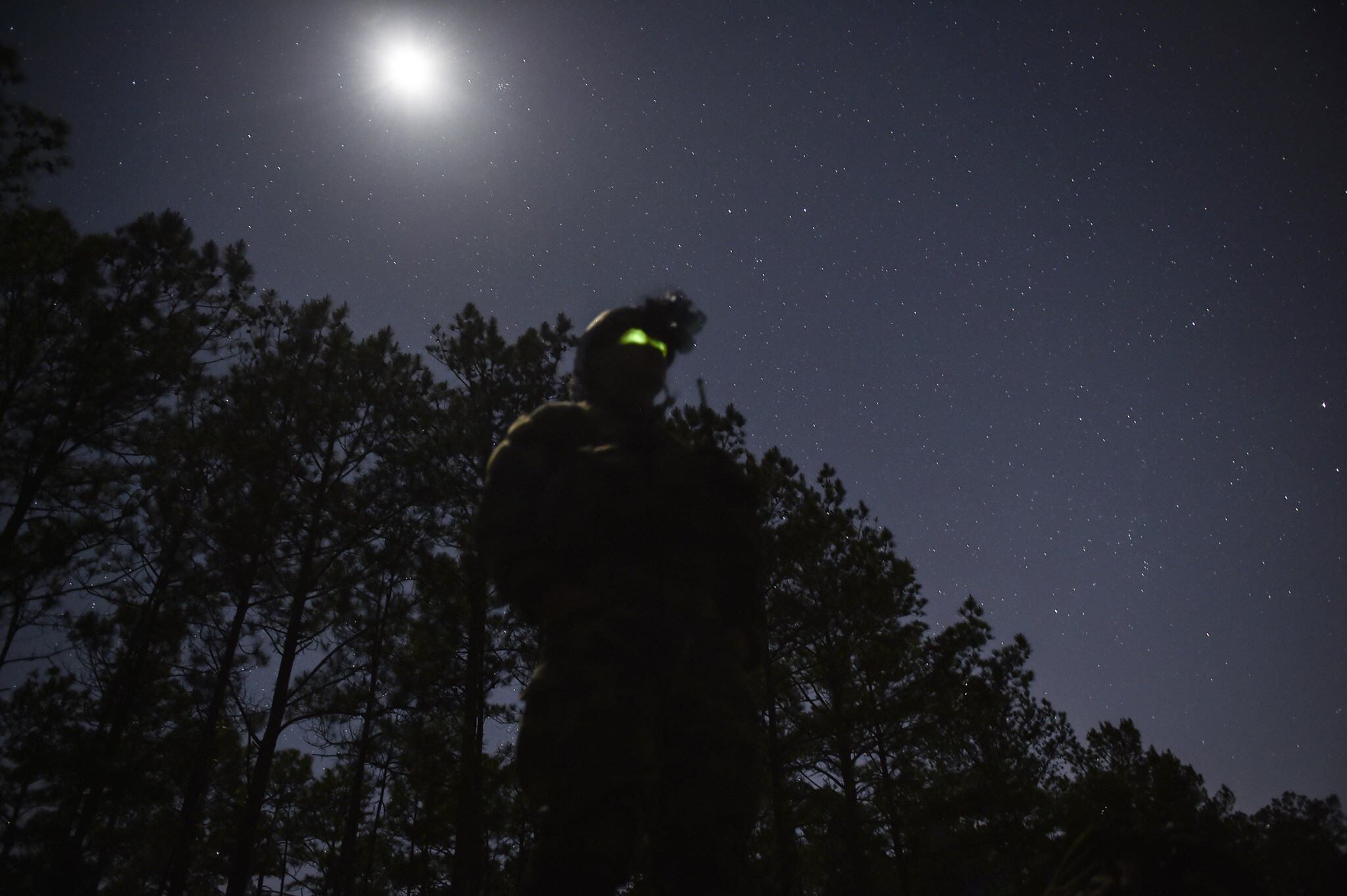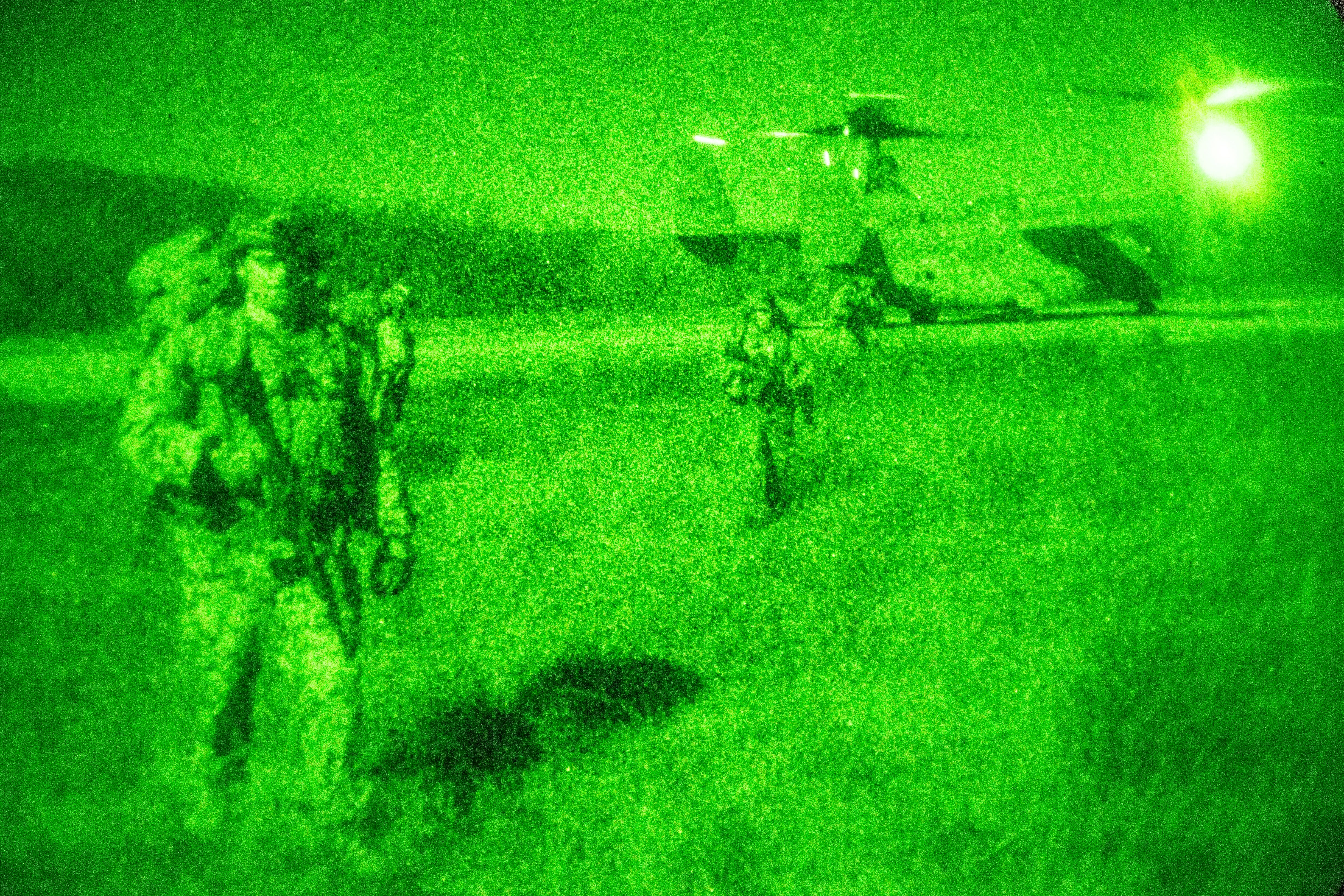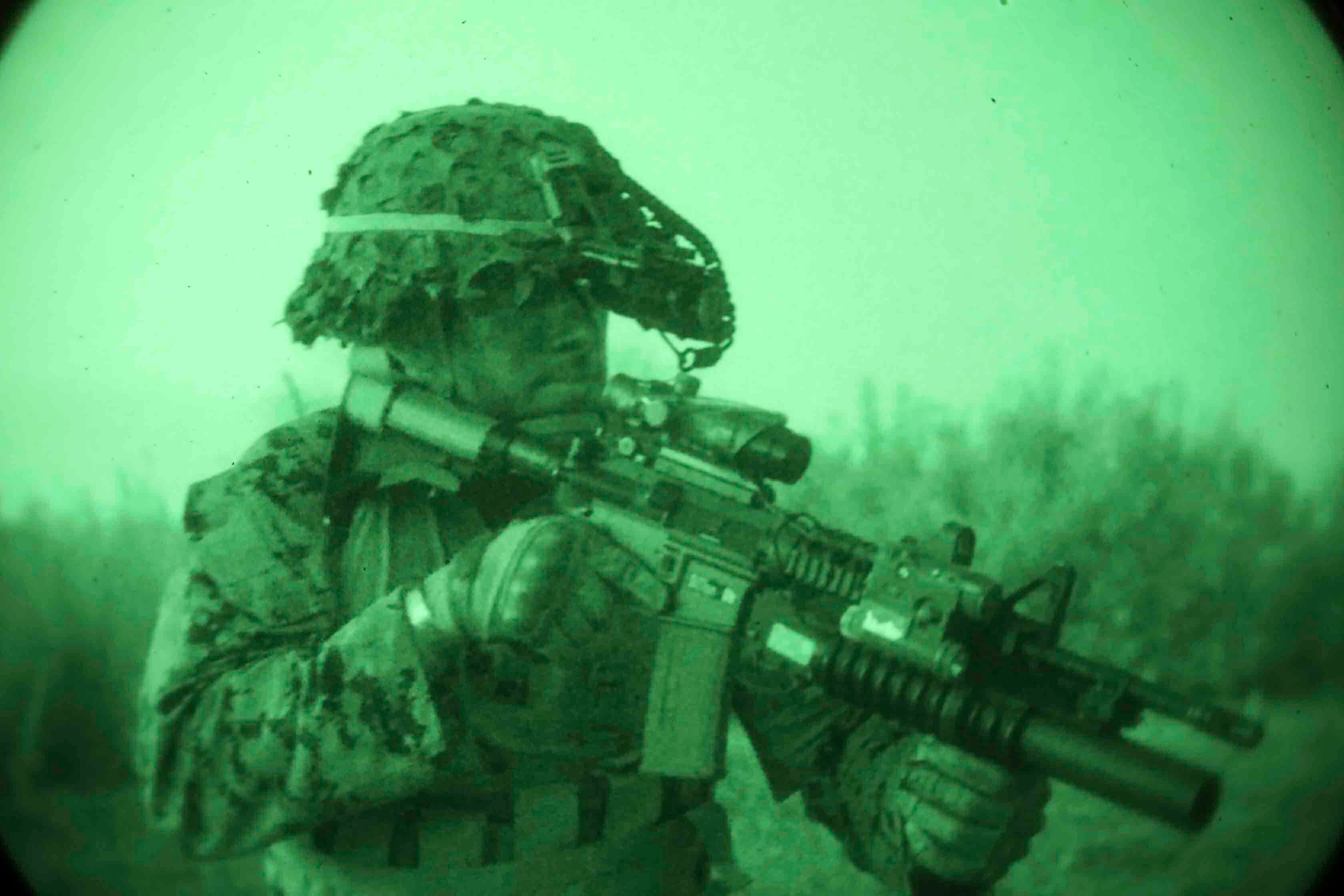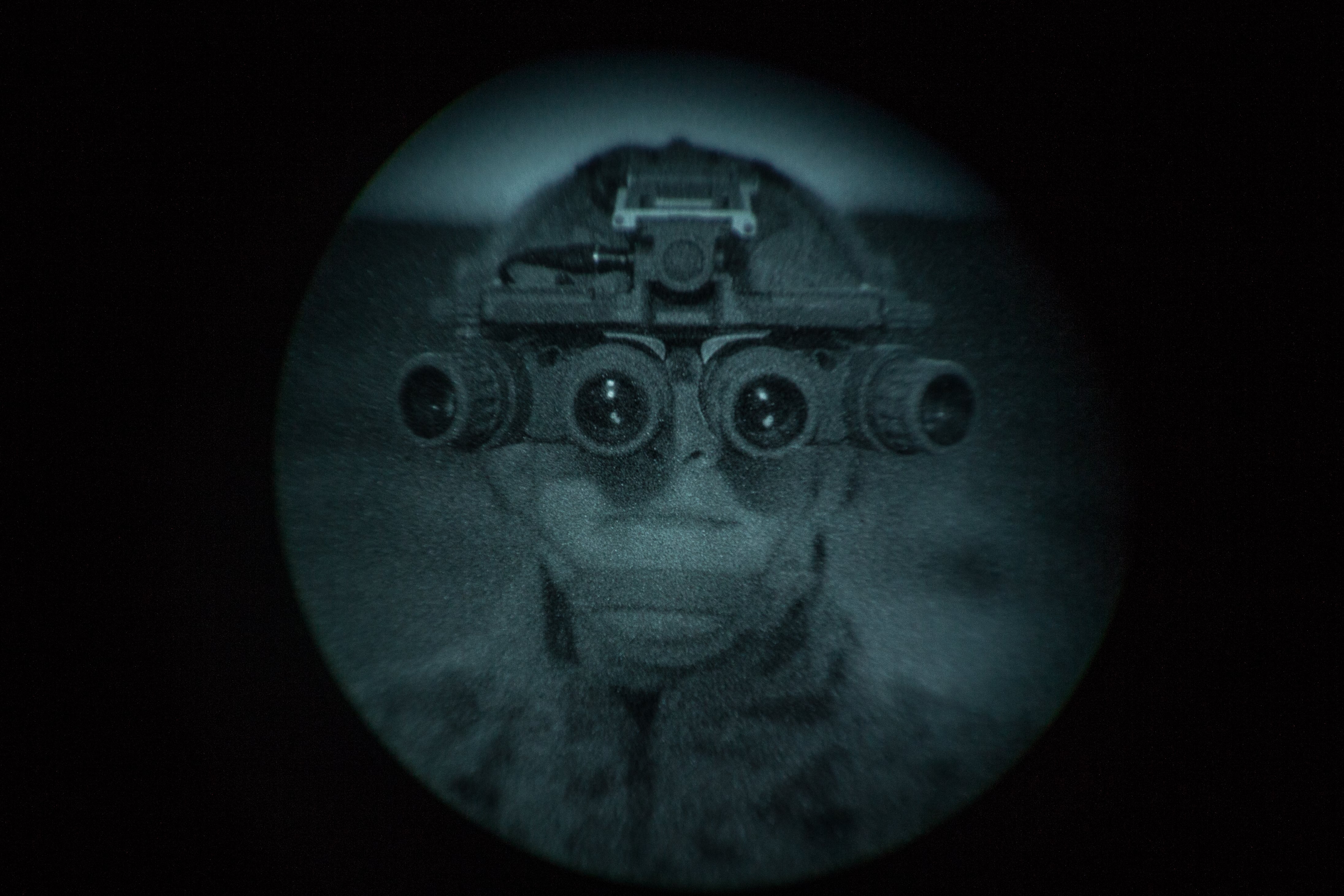A 15-Marine rifle squad dispatched to an island in the Pacific moves under the cover of darkness aided by new binocular night vision devices.
The Marines have just destroyed an enemy communications relay and are headed to a landing zone for extraction.
MV-22 Ospreys escorted by fighter aircraft are inbound to exfil the Marines.
The squad pauses and sets security in a tree line near a large clearing that’s wide enough for an Osprey to land.
As the Ospreys near, a tactical air controller with the Marines steps out of the tree line with an infrared chemlight fastened to a small rope and spins it in a circular motion. The Marine is signaling the approaching aircraft of the squad’s position and the landing zone.

Osprey pilots aided by night vision devices spot the signal, and one of the aircrafts prepares to land.
But, a small tactical Chinese drone equipped with night vision and infrared sensors has also spotted the Marine position.
The enemy drone signals to a nearby rocket artillery system emplaced on a barge towed by a Chinese ship at sea.
Precision rockets rain down on the Marine positions and destroy an Osprey on the ground.
The Marines take several casualties, and the Corps must weigh losing another Osprey to get the Marines to safety or postpone the extraction by several days until the area and airspace can be cleared.
It’s a nightmare scenario the Marine Corps and the U.S. military must train for as the technological edge in night vision capabilities, once dominated by the U.S., continues to erode to rising near-peer adversaries.
To compound the issue, the proliferation of thermal and night vision devices to terrorist and insurgent groups from Iraq, Syria and Afghanistan threaten U.S. and partner forces across the Middle East.
A recent Defense Department report noted that nearly 1,000 night vision devices provided to Afghan security forces were unaccounted for.
The Corps and the Army are now amid retooling a force that has taken for granted the security and cover provided by the night over the past 20 years of combat operations.
To regain dominance over the night, the U.S. military is looking at a slew of options from new ultrarealistic virtual trainers, upgraded night visions devices and technology, to free play exercises where troops are pitted against near-peer allied forces.
Virtual training systems are cost effective and afford Marines and soldiers the ability to train in a number of scenarios and various terrain.
The Corps is currently interested in two separate systems known as gunfighter gyms and night labs, according to Teresa Ovalle, a spokeswoman with Marine Corps Combat Development Command.
The gunfighter gym is a simulated marksmanship trainer that “can assist with evaluating a Marine’s decision-making ability in a variety of scenarios,” Ovalle told Marine Corps Times in an email.
“It can also record and playback a squad — and a squad leader’s — reactions to different and unexpected scenarios.”
A former member of the special operations community with knowledge of the gunfighter gyms, who spoke to Marine Corps Times on condition of anonymity, said the systems are about “refining the individual” warfighter.
He described the gunfighter gym as a big technological leap beyond the Indoor Simulated Marksmanship Trainer, already used across the Corps.
Gunfighter gyms allow units to change scenarios, terrain, environment, or day and night, the former special operator said.
A Marine can set the system to have their platoon “overwhelmed by a larger force that’s aided with night vision googles” and playback the scenario so troops can see how they reacted to various events, the former special operator said.
The Corps’ counterterrorism unit known as Marine Corps Security Force Regiment has experience training with the gunfighter gyms.
But Ovalle said the Corps has not yet identified a particular gunfighter gym for procurement.
Night lab systems train Marines on the proper use and maintenance of night vision devices, according to Ovalle.
The night labs are currently only in use by Marine Corps aviation units, but ground combat elements within the Corps have expressed interest in acquiring the systems to refine night vision skills, Ovalle said.
The gunfighter gyms have support from some senior officers within the Corps.
Lt. Gen Brian D. Beaudreault, the deputy commandant for plans, policies and operations, commented on the gunfighter gym’s ability to refine Marine skills for night operations. Beaudreault’s comments were made at a ground awards dinner in May.
And Maj. Daniel D. Yoo, the commanding general of the Marine Raiders, referenced the gunfighter gyms as a tool to help build the “cognitive Raider” for the near-peer battle ahead.
Yoo’s remarks about the gunfighter gyms were made at the Special Operations Forces Industry Conference held in Tampa, Florida, in May.
Training for the night
The Corps is also learning valuable lessons about nighttime operations as it battles allies in a series of free play exercises.
The Marines already have carried out a number of these exercises.
In October and November, Marines trained against a near-peer adversary in NATO’s largest exercise in more a decade, Trident Juncture.
In February, Marines battled British Royal Marines across the sprawling Twentynine Palms, California, training base — where scenarios involved nighttime operations.
And in March, Marines were in Sweden to participate in an iteration of exercise Northern Wind.
That exercise involved mechanized movements of Marines by BV-206 vehicles, anti-armor operations and nighttime scenarios, 1st Lt. Brian Carney, headquarters and support company commander for 3d Battalion, 8th Marines, told Marine Corps Times.

Carney said one of the biggest issues for the Marines was signature management when training against an opponent with similar capabilities.
The Marines training in Europe’s high-north have been learning new ways to employ camouflage netting and distribute their forces in a manner to conceal their positions and manage their visible signature, Carney said.
He explained that since Trident Juncture, the Marines have been flying drones over their own positions to gauge the signatures they were giving off.
The main tactical consideration that Army trainers have taken into the night vision peer concerns is to reduce soldier signature as much as possible. No force-on-force after action reviews or examples were immediately available, but in another arena the Army has been very public about how it is maintaining its nighttime advantage.
The Army has taken a technology-driven approach to solving night vision problems. In the next few months the first Enhanced Night Vision Goggle-Binocular devices will field to an Army unit out of Fort Bliss, Texas, that is leaving soon after for its rotation on the Korean peninsula.
Though the Fort Bliss unit gets them first, the Army plans to field 10,000 units across the close combat — infantry, special operations forces, engineers and scouts — over the next two years. Marines of the same description will field 3,100 systems in the same period.
That device radically enhances the depth perception and field of view and clarity of night vision, including seeing through obscurants such as smoke and dust, for the troops using them. And it adds new targeting capabilities still being developed. But it’s actually somewhat of an interim capability.
It’s interim because over the past year the Army has partnered with Microsoft’s HoloLens team to incorporate a host of functions into a device that used to only help troops see at night.
The Integrated Augmented Visualization System, or IVAS, is still in development but is expected to field within the next five to eight years a total battlefield vision system.
“No other piece of equipment has had this kind of impact since the introduction of night vision,” Undersecretary of the Army Ryan McCarthy, a former Army Ranger told Marine Corps Times. “This takes night vision to the Ph.D. level.”
Instead of ‘owning the night,’ the goggle will allow a single soldier or Marine to own the spectrum of conflict, seeing data fed from higher command and sending back what that troop’s sensors are picking up. It will include navigation wayfinding points, thermal overlay, white phosphorous night vision (meaning no more green glow), marking elements to note enemy and friendly positions. And all of that can be shared among squad members.

And users can use small drone camera footage to recreate the battlefield they’ll soon fight on. That way they can conduct virtual training rehearsals before stepping off on almost any mission on a simulation of the actual territory where they’ll fight.
Other training options include putting video game-like avatars into training scenarios. The goggle will also allow for muzzle placement, reaction time and biometric feedback to be recorded and a video playback feature so that squad or team leaders can assess performance by their subordinates.
The device’s wireless capability looks to allow squad leaders to immediately see what their squadmates see as soon as they enter a ‘bubble’ within a few meters of the soldier or Marine.
The device will also link to the warfighter’s weapon, allowing them to toggle between goggle view, weapon sight view or a ‘picture-in-picture’ that would let them see both.
A Marine Corps Times reporter has worn the prototype of the IVAS and used the software in the goggle, known as “rapid target acquisition.” The combination allows for the user to see through smoke and dust in daylight or nighttime and use the weapon camera to shoot from the hip or shoot around corners without being exposed.
The marksmanship changes noted in the first small-batch were impressive.
Late in 2018, Brig. Gen. Dave Hodne, director of the Army’s Soldier Lethality Cross-Functional Team and Infantry School commandant, shared results of recent ENVG-B testing on the range with Marine Corps Times.
Shooters using the ENVG-B saw 100 percent improvement with M4 carbine qualification, 300 percent improvement on detecting targets, and a 30 percent to 50 percent decrease in time to employ their weapon.
They expect to have a prototype by November 2020 and anticipate fielding the first units in the 2025 to 2028 time frame.




